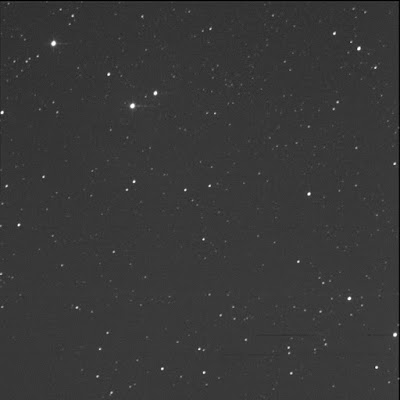In early February, I programmed the BGO 'bot to image the region of the sky centred on Tycho 02678-0101 1 in Cygnus. This is the apparent location of the double star SEI 774. According to the Washington Double Star catalogue, this is a "dubious" double, with a single observation in 1895.
The early morning message from the SMU robotic observatory noted an error and the downloaded archive data set does not include a blue filtered channel. I suspect the sky was getting too bright. Still, I was not concerned as the full-spectrum image was good quality.
Luminance only, 2 seconds subexposures, 12 stacked shots. FITS Liberator, GIMP. North is up; east is left.
From the WDS:
target: SEI 774
discoverer: Scheiner, J.
ID: 19596+3510
PA: 105; sep 25.4
mags 11.8 and 12.67
notes: X B
precise: 195937.60+350951.0
Near the centre of the image are two similar stars, nearly horizontally oriented. The left one is Tycho 02678-0101 1 at magnitude 11.64 (Tycho-2). I don't what the star to the right is, for certain. SkyTools 3 Pro shows a much dimmer star here, GSC 02678-1169. In my image, that stars looks to be effectively the same brightness. From Tycho, the position angle is 280 degrees with a separation of 89 seconds of arc. Not the missing pair.
South-west of Tycho is a pair of wide and rather faint stars. ST3P says they have magnitudes 15.0 and 15.1. Wow. Very faint. Curiously, they are aligned so to point to the Tycho star with the brighter star closest. From Tycho, 45° and 215". The "companion" from the brighter star: 226° and 23". Not the missing pair. But that separation is indicative: that's the spacing I'm looking for.
To the east of Tycho is a bright pair. Actually, they are slightly unequal, which is promising. They are at an intriguing angle, which is interesting. But the data from ST3P suggests this is not our quarry. The brighter star at the top-right is GSC 02678-0557 at magnitude "10.87 (poor quality)" with second star TYC 02678-2123 1 at magnitude 12.49 (Tycho-2). Huh. The luminosity of the stars sounds right. The PA and sep is 139 and 38. Blergh. Close but not close enough?
Top-centre of the image from Halifax. There's a dim, unequal pair. 106° at 28". Oh ho. Good positional numbers. But the magnitudes of 13.94 and fainter don't match. Not the missing pair.
Near the top-right of the image is another pair of stars, similar in angle and spacing. The planning app says this is GSC 02678-1079 at mag 12.82 and GSC 02678-1149, mag 13.14. PA 151, sep 28. These aren't the stars we're looking for...
So, did SEI improperly identify GSC 02678-0557? It's the best possible candidate I think. ST3P says the location of the bright member is RA 19h59m55.2s and Dec +35°13'16" (J2000). The Right Ascension number is pretty good; the Declination is off by 3 minutes positive.
It's difficult to conclude anything...
I'll see if I can find some other images for the region, see if anything is moving...
Lots of other interesting "pairs" of stars in this image...
§
Imaged again on 8 May '20.
Sunday, February 23, 2020
Subscribe to:
Post Comments (Atom)



No comments:
Post a Comment